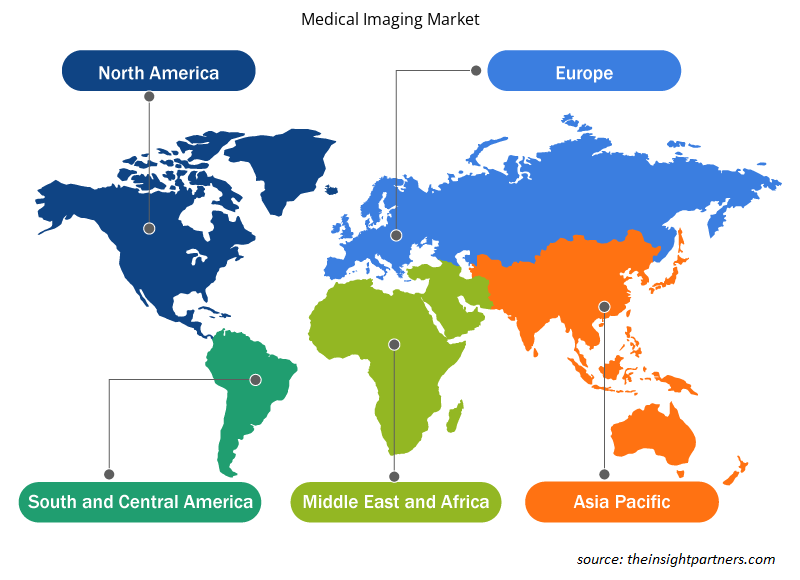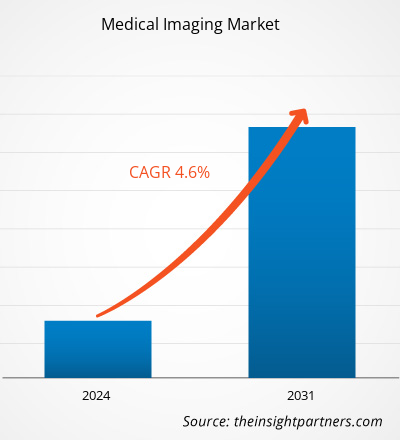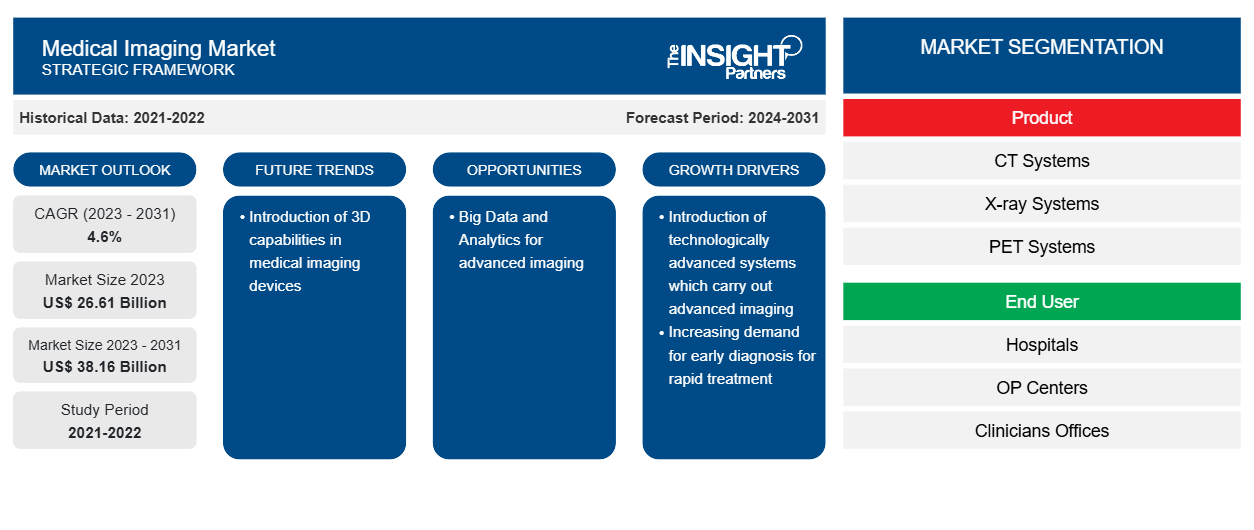Der Markt für medizinische Bildgebung wird voraussichtlich von 26,61 Milliarden US-Dollar im Jahr 2023 auf 38,16 Milliarden US-Dollar im Jahr 2031 anwachsen. Der Markt wird zwischen 2023 und 2031 voraussichtlich eine durchschnittliche jährliche Wachstumsrate von 4,6 % verzeichnen. Die Einführung von 3D-Funktionen in medizinischen Bildgebungsgeräten wird voraussichtlich der wichtigste Trend auf dem Markt bleiben.
Marktanalyse für medizinische Bildgebung
Die steigende Nachfrage nach Frühdiagnosen von Krankheiten und die Ausweitung des Anwendungsbereichs klinischer Anwendungen, die rasch wachsende geriatrische Bevölkerung und die damit einhergehende Zunahme der Prävalenz damit verbundener Krankheiten , technologische Fortschritte in der Branche der diagnostischen Bildgebung sowie steigende Investitionen, Mittel und Zuschüsse öffentlich-privater Organisationen treiben das Wachstum des Marktes für medizinische Bildgebung voran. Darüber hinaus treiben staatliche Initiativen zur Förderung der medizinischen Bildgebung zur Krankheitsvorbeugung, steigende Investitionen in F&E-Aktivitäten zur Entwicklung innovativer medizinischer Bildgebung und die zunehmende Einführung medizinischer Bildgebung in Entwicklungsländern das Wachstum des Marktanteils voran.
Marktübersicht für medizinische Bildgebung
Geografisch gesehen wird der asiatisch-pazifische Raum im Prognosezeitraum 2023–2031 voraussichtlich die höchste durchschnittliche jährliche Wachstumsrate verzeichnen. Der zunehmende Fokus der Marktteilnehmer auf die Einführung technologisch entwickelter medizinischer Bildgebung für verschiedene Krankheiten treibt das Wachstum des Marktes voran. Indien gehört zu den 20 größten Herstellern medizinischer Geräte weltweit und ist der viertgrößte Hersteller medizinischer Geräte in Asien, gefolgt von Japan, China und Südkorea. Das Land dürfte aufgrund seiner über eine Milliarde Einwohner zählenden Bevölkerung, seines Gesundheitsbewusstseins, seines wirtschaftlichen Wohlstands, seiner technologischen Expertise, seiner Ausbildung von Fachkräften und der Entwicklung von Einrichtungen im Gesundheitsbereich ein potenzielles Wachstum verzeichnen.
Passen Sie diesen Bericht Ihren Anforderungen an
Sie erhalten kostenlos individuelle Anpassungen an jedem Bericht, einschließlich Teilen dieses Berichts oder einer Analyse auf Länderebene, eines Excel-Datenpakets sowie tolle Angebote und Rabatte für Start-ups und Universitäten.
-
Holen Sie sich die wichtigsten Markttrends aus diesem Bericht.Dieses KOSTENLOSE Beispiel umfasst eine Datenanalyse von Markttrends bis hin zu Schätzungen und Prognosen.
Treiber und Chancen auf dem Markt für medizinische Bildgebung
Steigende Nachfrage nach Frühdiagnose begünstigt den Markt
Diagnostische Tests sind ein entscheidender Bestandteil des Gesundheitssystems, da sie wichtige Informationen liefern, die es Anbietern und Patienten ermöglichen, die richtigen klinischen Entscheidungen zu treffen. Rund 75 % der klinischen Entscheidungen basieren auf einem diagnostischen Test. Die Nachfrage nach schnelleren und präziseren Diagnosen steigt jährlich um 10 %, was die Kosten erhöht und die Kapazität und Leistungsfähigkeit der Diagnoseanbieter unter Druck setzt. Aus Sicht des Patienten können Früherkennung und Diagnose unnötige Schmerzen und Leiden verhindern. Sie können auch den Umfang und die Kosten der Behandlung reduzieren. Zahlreiche Forschungsarbeiten bringen Frühdiagnosen mit messbaren gesundheitlichen Vorteilen in Verbindung, wie z. B. verbesserten Überlebensraten und niedrigeren Behandlungskosten. Darüber hinaus wird die Sensibilisierung der Regierung das Marktwachstum weiter vorantreiben. So zielen die Kampagnen „Be Clear on Cancer“ darauf ab, die Früherkennung von Krebs zu verbessern, indem sie die Öffentlichkeit auf Anzeichen und Symptome von Krebs aufmerksam machen und die Menschen ermutigen, unverzüglich ihren Hausarzt aufzusuchen. Public Health England ist für das Programm verantwortlich und arbeitet mit dem Gesundheitsministerium und dem NHS England zusammen. Somit treibt eine steigende Nachfrage nach Frühdiagnosen das Wachstum des Marktes für medizinische Bildgebung voran.
Big Data und Analytics bieten Chancen für Marktwachstum
Laut einem Artikel auf ITN, in dem das Potenzial von Big Data in der diagnostischen Bildgebung diskutiert wurde, gaben Dhaval Shah und Prashanth Kollaikal von CitiusTech an, dass es neue und interessante Funktionen in den Radiologieinformationssystemen (RIS) und PACS-Systemen gibt, insbesondere in denen in der Cloud. Diese könnten auch Analysen und beeindruckende Berichte über operative und klinische Daten umfassen, heißt es in dem Artikel. Unternehmensweite Key Performance Indicators (KPIs) werden aus einer Vielzahl von Quellen abgeleitet. Diese KPIs werden im Allgemeinen verwendet, um den Anforderungen des Anbieters gerecht zu werden und die klinische und operative Effizienz sowie den Komfort des Patienten zu berücksichtigen. Obwohl diese KPIs seit vielen Jahren zur Optimierung verwendet werden, lässt sich die Gesamteffizienz leicht messen und mit der technologischen Kompetenz von Geräten, erweiterten Modalitäten, fortschrittlichen Softwaresystemen und mobilen Geräten verbessern. Daher bietet der zunehmende Fokus auf die Verwendung von Angebotsdaten und Analysen in der medizinischen Bildgebung eine Chance für das Wachstum des Marktes für medizinische Bildgebung.
Segmentierungsanalyse des Marktberichts zur medizinischen Bildgebung
Wichtige Segmente, die zur Ableitung der Marktanalyse für medizinische Bildgebung beigetragen haben, sind Produkt und Endbenutzer.
- Basierend auf dem Produkt ist der Markt für medizinische Bildgebung in CT-Systeme, Röntgensysteme, PET-Systeme, MRT-Systeme, Ultraschallsysteme und andere unterteilt. Das Segment der Röntgensysteme hatte im Jahr 2023 den größten Marktanteil.
- Basierend auf dem Endnutzer ist der Markt für medizinische Bildgebung in Krankenhäuser, OP-Zentren, Arztpraxen und Notfallzentren unterteilt. Das Krankenhaussegment hatte im Jahr 2023 den größten Marktanteil.
Marktanteilsanalyse für medizinische Bildgebung nach Geografie
Der geografische Umfang des Marktberichts zur medizinischen Bildgebung ist hauptsächlich in fünf Regionen unterteilt: Nordamerika, Asien-Pazifik, Europa, Naher Osten und Afrika sowie Süd- und Mittelamerika.
Nordamerika dominiert den Markt. Das Wachstum in Nordamerika ist gekennzeichnet durch eine steigende Nachfrage nach medizinischer Bildgebung und Dienstleistungen von Krankenhäusern und Kliniken, eine steigende Zahl von Patienten, die sich diagnostischen Bildgebungsverfahren unterziehen, ein hohes Bewusstsein der Patienten, günstige Erstattungsszenarien und höchste Ausgaben im Gesundheitswesen. Darüber hinaus dürften die steigende Zahl geriatrischer Bevölkerung, die steigende Zahl chronischer Krankheiten und die steigende Zahl von Zentren für diagnostische und medizinische Bildgebung in den Ländern der Region für das Wachstum des nordamerikanischen Marktes für medizinische Bildgebung in den Prognosejahren verantwortlich sein. In den USA gibt es viele Kliniken für moderne chirurgische Behandlungen und eine steigende Zahl orthopädischer chirurgischer Verfahren. Die steigende Zahl geriatrischer Bevölkerung ist einer der Faktoren für das Wachstum des Marktes. Der Anstieg der alternden Bevölkerung spiegelt eine steigende Zahl von Menschen wider, die sich medizinischen Behandlungen unterziehen. Die zunehmende Verbreitung von Krebs wird voraussichtlich die Nachfrage nach medizinischen Bildgebungsgeräten in den USA erhöhen.
Regionale Einblicke in den Markt für medizinische Bildgebung
Die regionalen Trends und Faktoren, die den Markt für medizinische Bildgebung im Prognosezeitraum beeinflussen, wurden von den Analysten von Insight Partners ausführlich erläutert. In diesem Abschnitt werden auch die Marktsegmente und die Geografie für medizinische Bildgebung in Nordamerika, Europa, im asiatisch-pazifischen Raum, im Nahen Osten und Afrika sowie in Süd- und Mittelamerika erörtert.

- Erhalten Sie regionale Daten zum Markt für medizinische Bildgebung
Umfang des Marktberichts zur medizinischen Bildgebung
| Berichtsattribut | Details |
|---|---|
| Marktgröße im Jahr 2023 | 26,61 Milliarden US-Dollar |
| Marktgröße bis 2031 | 38,16 Milliarden US-Dollar |
| Globale CAGR (2023 - 2031) | 4,6 % |
| Historische Daten | 2021-2022 |
| Prognosezeitraum | 2024–2031 |
| Abgedeckte Segmente |
Nach Produkt
|
| Abgedeckte Regionen und Länder |
Nordamerika
|
| Marktführer und wichtige Unternehmensprofile |
|
Dichte der Marktteilnehmer im Bereich der medizinischen Bildgebung: Die Auswirkungen auf die Geschäftsdynamik verstehen
Der Markt für medizinische Bildgebung wächst rasant. Dies wird durch die steigende Nachfrage der Endnutzer aufgrund von Faktoren wie sich entwickelnden Verbraucherpräferenzen, technologischen Fortschritten und einem größeren Bewusstsein für die Vorteile des Produkts vorangetrieben. Mit der steigenden Nachfrage erweitern Unternehmen ihr Angebot, entwickeln Innovationen, um die Bedürfnisse der Verbraucher zu erfüllen, und nutzen neue Trends, was das Marktwachstum weiter ankurbelt.
Die Marktteilnehmerdichte bezieht sich auf die Verteilung der Firmen oder Unternehmen, die in einem bestimmten Markt oder einer bestimmten Branche tätig sind. Sie gibt an, wie viele Wettbewerber (Marktteilnehmer) in einem bestimmten Marktraum im Verhältnis zu seiner Größe oder seinem gesamten Marktwert präsent sind.
Die wichtigsten auf dem Markt für medizinische Bildgebung tätigen Unternehmen sind:
- Allgemeine Elektrizit?tsgesellschaft
- Siemens AG
- Koninklijke Philips NV
- SHIMADZU CORPORATION
- Hitachi, Ltd.
- Canon Inc.
Haftungsausschluss : Die oben aufgeführten Unternehmen sind nicht in einer bestimmten Reihenfolge aufgeführt.

- Überblick über die wichtigsten Akteure auf dem Markt für medizinische Bildgebung
Neuigkeiten und aktuelle Entwicklungen zum Markt für medizinische Bildgebung
Der Markt für medizinische Bildgebung wird durch die Erhebung qualitativer und quantitativer Daten nach Primär- und Sekundärforschung bewertet, die wichtige Unternehmensveröffentlichungen, Verbandsdaten und Datenbanken umfasst. Nachfolgend sind einige der Entwicklungen auf dem Markt für medizinische Bildgebung aufgeführt:
- FUJIFILM India hat auf der 75. Nationalkonferenz der Indian Radiological and Imaging Association (IRIA) sein Produkt- und Lösungsportfolio erweitert. Die auf der IRIA 2023 vorgestellten Arietta 850 DeepInsight und Arietta 650 DeepInsight sind die neuesten Ultraschalltechnologie-Angebote von FUJIFILM India. Die neue Bildgebungsmarke „DeepInsight“ besteht aus 5 Elementen: Genauigkeit, Reproduzierbarkeit, Sichtbarkeit, Effizienz und Nutzung von KI. (Quelle: Fujifilm, Unternehmenswebsite, Februar 2023)
- FUJIFILM Healthcare Americas Corporation erhielt die FDA 510(k)-Zulassung für sein neues 1,5-Tesla-Magnetresonanztomographiesystem (MRT), das ECHELON Synergy. Das System verwendet Synergy DLR, Fujifilms proprietäre Deep Learning Reconstruction (DLR)-Technologie auf Basis künstlicher Intelligenz (KI), um die Bildschärfe zu verbessern und Scans schneller zu erfassen, was zu einem höheren Durchsatz, einer höheren Bildqualität und einer höheren Patientenzufriedenheit beiträgt. (Quelle: Fujifilm, Unternehmenswebsite, August 2023)
Marktbericht zur medizinischen Bildgebung – Umfang und Ergebnisse
Der Bericht „Marktgröße und Prognose für medizinische Bildgebung (2021–2031)“ bietet eine detaillierte Analyse des Marktes, die die folgenden Bereiche abdeckt:
- Marktgröße und Prognose für Schnelltestkits auf globaler, regionaler und Länderebene für alle wichtigen Marktsegmente, die im Rahmen des Berichts abgedeckt sind
- Markttrends für Schnelltestkits sowie Marktdynamik wie Treiber, Einschränkungen und wichtige Chancen
- Detaillierte PEST/Porters Five Forces- und SWOT-Analyse
- Marktanalyse für Schnelltestkits mit Blick auf wichtige Markttrends, globale und regionale Rahmenbedingungen, wichtige Akteure, Vorschriften und aktuelle Marktentwicklungen
- Branchenlandschaft und Wettbewerbsanalyse, einschließlich Marktkonzentration, Heatmap-Analyse, prominenten Akteuren und aktuellen Entwicklungen auf dem Markt für medizinische Bildgebung
- Detaillierte Firmenprofile
- Historische Analyse (2 Jahre), Basisjahr, Prognose (7 Jahre) mit CAGR
- PEST- und SWOT-Analyse
- Marktgröße Wert/Volumen – Global, Regional, Land
- Branchen- und Wettbewerbslandschaft
- Excel-Datensatz
Aktuelle Berichte
Verwandte Berichte
Erfahrungsberichte
Grund zum Kauf
- Fundierte Entscheidungsfindung
- Marktdynamik verstehen
- Wettbewerbsanalyse
- Kundeneinblicke
- Marktprognosen
- Risikominimierung
- Strategische Planung
- Investitionsbegründung
- Identifizierung neuer Märkte
- Verbesserung von Marketingstrategien
- Steigerung der Betriebseffizienz
- Anpassung an regulatorische Trends























 Kostenlose Probe anfordern für - Markt für medizinische Bildgebung
Kostenlose Probe anfordern für - Markt für medizinische Bildgebung